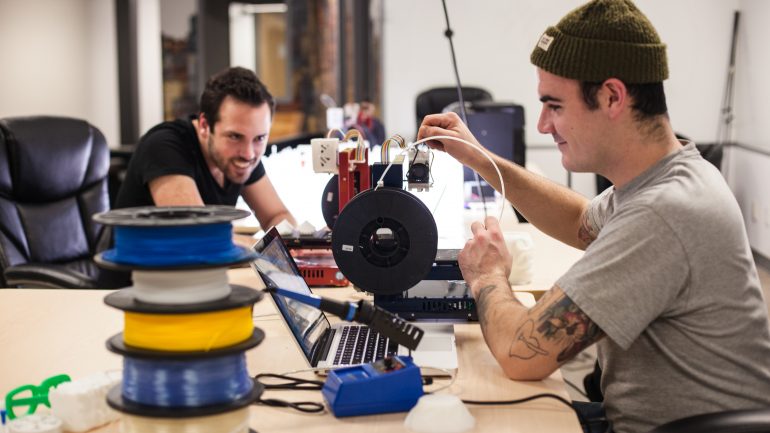Ever wanted to get up close and personal with a 3D printer?
MakeLab, Toronto’s largest hands-on 3D printing playground and studio now offers drop-in sessions in a brand new space at College and Dufferin.
The rise of interest in 3D printing and more accessible mini computing like Arduino and Raspberry Pi is contributing to the revival of DIY maker culture in the city. MakeLab is the latest addition to what looks like a flourishing family of local makerspaces – physical spaces that bring like-minded people together to share ideas, access tools and learn new skills. HacklabTO, Toronto’s hacker collective is moving to a bigger space thanks to a successful crowdfunding campaign. Toronto Tool Library also successfully raised funds to open a second location on the east end of the city. Maker Kids in Roncesvalles and Site 3 coLaboratory on Ossington also run regular events and meetups, as the list of maker spaces in Toronto keeps growing.
MakeLab, meanwhile, wants to be an easy starting point for people who wouldn’t actively look for maker spaces, because they wouldn’t know what ‘maker’ even means.
“There are almost three million people living in the city, so there’s a huge number of Torontonians that wouldn’t even consider 3D printing as an option, and we are here for them,” said founder Jonathan Moneta. “It’s actually somewhat hard to get into 3D printing in the city. Most maker spaces offer design workshops and give fairly little first-hand experience with the actual printing. We focus on 3D printing and public engagement, we can have someone here at all times to always be a resource to people while allowing for creative freedom. We do one-one-one training sessions on design, how to set the setting on the printer, how to operate it and how to send the files to the printer.”
Considering you can 3D print almost anything, from chocolate to human skin to guns, 3D printing is indeed the future of printing.
Equipped with a fleet of ten consumer-grade fused deposition modeling (FDM) 3D printers, MakeLab recently partnered with the Royal Ontario Museum (ROM). They gave several people who had never saw a 3D printer before an experience of collectively designing and printing a full DIY Mesopotamian city.
Moneta, who I worked with on the organizing team of Toronto Maker Faire, proudly calls the event at the ROM “the largest public 3D printing demo in the world, with ten 3D printers in operation concurrently.”
Shelley Vaisberg, an occupational therapist who dropped by MakeLab, drew her signature with finger and printed it. She now wants one 3D printed out of rubber, so she can dip it into ink. “I have never done anything like this before, and it was very easy and pretty awesome. I sign my name a lot at work, and this 3D printed rubber signature would make a great stamp,” says Vaisberg.
In addition to drop-in sessions, which are reasonable $35 per hour and $15 per hour for all-you-can-print option, MakeLab plans to run more large 3D printing events and host community nights. According to Moneta, Thursday January 16 will be a 3D Printed Nails and Rings night.
No 3D printed neon Yoda heads, the usual suspects of most makerspaces that use them to prove proper calibration, were spotted on the premises. Or in other words, MakeLab is not as nerdy as the rest of makerspaces in TO. It’s a pretty nice and artsy space. I saw some funky art on the walls, couches, and that stunning Mesopotamian city from the ROM. Can 3D printing be easy, pleasant, accessible and, well, normal activity to do on a weekday night? We’ll watch MakeLab closely to find out.



